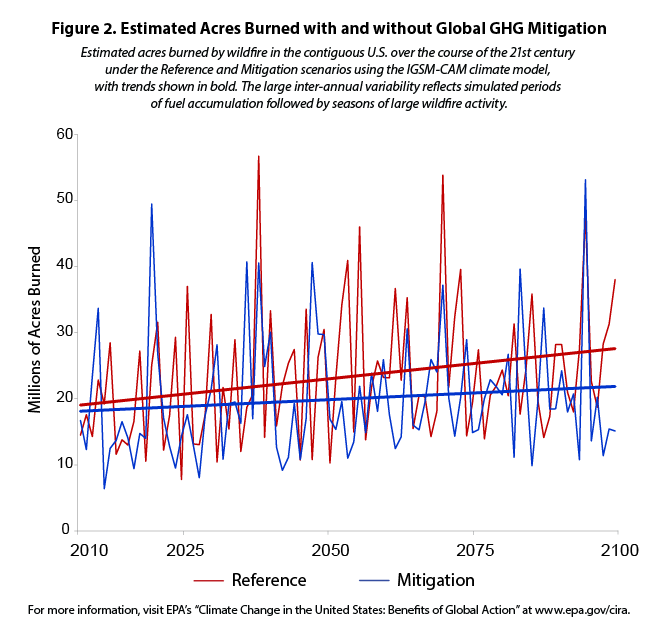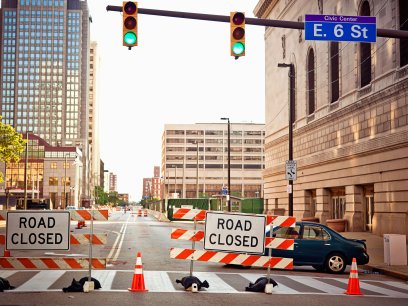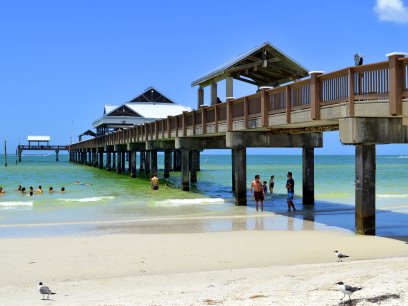
Did you know?
- Landscape fire smoke accounts for hundreds of thousands of deaths annually due to associated respiratory and cardiovascular infections.
- Carbon dioxide emissions from wildfires in the western US have more than doubled since the 1980s.
- Nine of the ten years with the largest acreage burned by wildfires in the US have occurred since 2000. This period coincides with many of the warmest years on record nationwide.
Forest fires can occur naturally and are sometimes human-induced through controlled burns to improve the health of local ecosystems. When fires occur in areas with high temperatures, drought, and/or other disturbances they can turn into wildfires that damage property, disrupt ecosystem services, destroy timber stocks, resulting in the loss of human life, and impair air and water quality.
The occurrence of large wildfires and the duration of the wildfire season across the United States have increased over the past few decades. Over the past 30 years, the western US and Alaska have seen an increase in hot and dry conditions. Over that same time period, there has also been in increase in the area that burns each year. According to the National Interagency Fire and Data Center, nine of the 10 years with the largest amount of acres burned have occurred since 2000, coinciding with many of the warmest years on record for the United States.
Climate models predict that an increase in greenhouse gas emissions will result in even drier and warmer conditions and larger and longer-lasting wildfires. The graphic below from the US EPA's report, Climate Change in the United States: Benefits of Global Action, shows the estimated acres burned with (mitigation) and without (reference) global greenhouse gas emissions reductions over time. According to EPA, if greenhouse gas emissions are reduced over the course of the 21st century, the amount of US forested land that can be prevented from burning by 2100 will be two to three times the size of California, saving $8.6 to $11 billion in wildfire response costs and $3.4 billion in fuel management costs on conservation lands. Without reductions over the course of the 21st century, approximately 5.3 million more acres of forested land (the size of Massachusetts) in the US is projected to burn each year at the end of the century compared to today.

Learn More:
Check out NASA's "Potential Evaporation in North America through 2100" video, which shows the projected drying potential of North America through 2100. These projections suggest that the increased drying will also increase the risk of fire in the Great Plains and Upper Midwest by the end of the 21st century.
Check out the "2012 and the Future of Fire" video below to learn how NASA scientists use satellites to predict the intensity and longevity of future wildfire seasons.
What You Can Do:
- Take action to protect your family and home from from wildfires with these tips.
Sources:
- CDC. 2014. "Climate and Health: Wildfires." Accessed July 10 2018. http://www.cdc.gov/climateandhealth/effects/wildfires.htm.
- NASA. 2012. "Climate Models Project Increase in U.S. Wildfire Risk." Accessed July 10, 2018. http://www.nasa.gov/topics/earth/features/climate-fire.html.
- NASA. 2013. "NASA ‘Fire Towers' in space watch for Wildfires on the Rise." Accessed July 10, 2018. http://www.nasa.gov/content/goddard/nasa-fire-towers-in-space-watch-for….
- National Interagency Fire Center. 2016. Total Wildland Fires and Acres (1960-2015). Accessed July 10, 2018. https://www.nifc.gov/fireInfo/fireInfo_stats_totalFires.html.
- US EPA. 2015. "Climate Action Benefits: Wildfire." Accessed July 10, 2018. http://www2.epa.gov/cira/climate-action-benefits-wildfire.
- US EPA. 2016. "Climate Indicators:Wildfires." Accessed July 10, 2018. http://web.archive.org/web/20160512002554/https://www3.epa.gov/climatec….
- US FWS. 2006. Benefits of Fire. Accessed July 10, 2018. http://www.fws.gov/fire/downloads/Benefits%20of%20Fire%20Case%20Studies…


